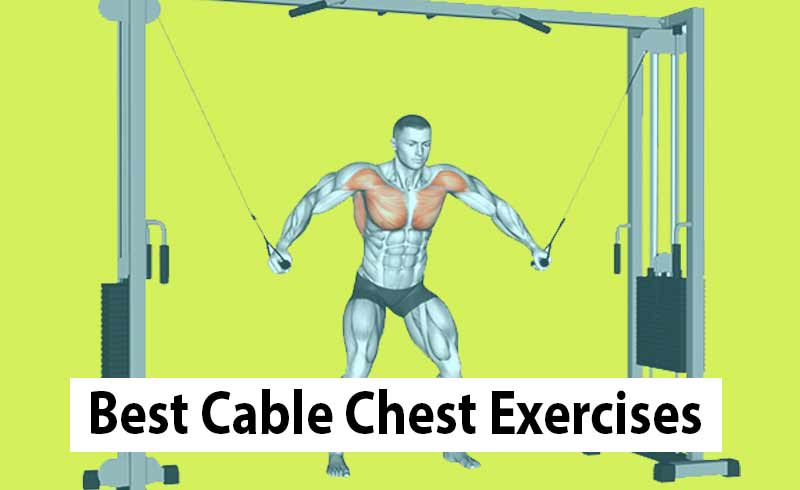The most crucial workouts for developing the size, strength, and blood flow to your chest are cable chest exercises. You should incorporate these workouts into your training regimen if you want to develop your chest.
Chest cable exercises are similar to other cable exercises targeting different muscles in the body. They primarily target the chest muscles and also engage the shoulder and triceps muscles as helpers.
Some people may overlook cable chest exercises, but they are actually very crucial and impact all the fibers of the chest muscles.
Let’s continue and provide you with a guide on how to perform these exercises correctly and safely.
In this article, we will cover the following:
- Understanding Chest Anatomy
- Top Cable Chest Exercises
- Step-by-step Guide and Expert Tips
- Customizing Your Training Plan According to Your Goals
- Workout Examples/Programs for Beginners, Intermediates, and Advanced Levels
- Advantages of Incorporating Cable Chest Exercises into Your Training Routine
Chest Anatomy Explained
Muscles of the Chest:
Now, what are the Four Pectoral Muscles?
1. Pectoralis Major:
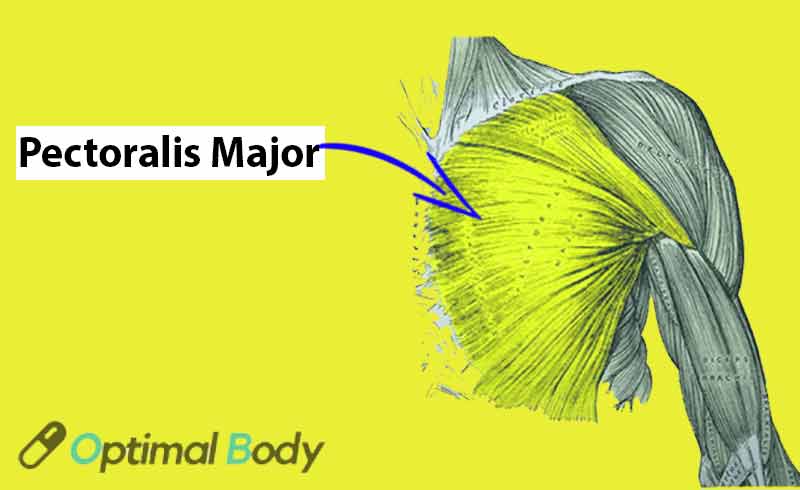
The Pectoralis Major is a large and important muscle in the body. It is visible in men but covered by breasts in women.
Its origin is from the upper front part of the collarbone, a portion of the breastbone, and the upper six ribs.
It is composed of three main parts: the clavicular part, the sternocostal part, and the abdominal part.
This muscle contributes to pulling the arms toward the body and also aids in the process of breathing.
2. Pectoralis Minor:

The Pectoralis Minor is a small triangular muscle located in the upper part of the chest, beneath the Pectoralis Major.
Its origin is from the third, fourth, and fifth ribs near their cartilages. This muscle is responsible for pulling the shoulder bones downward and pushing them forward at a lower angle.
3. Serratus Anterior:
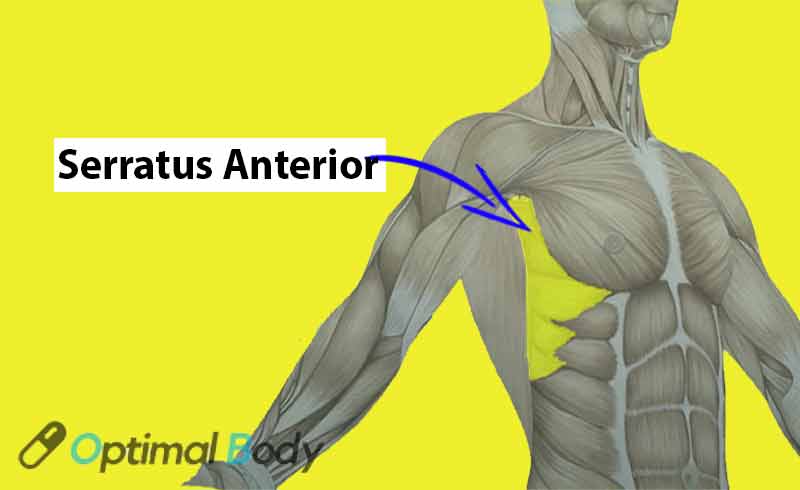
The Serratus Anterior is one of the three muscles found in the chest area.
It is of medium length and connects between the shoulder blade and the upper eight ribs.
It plays an important role in stabilizing and returning the shoulder to its natural position.
4. Subclavius Muscle:
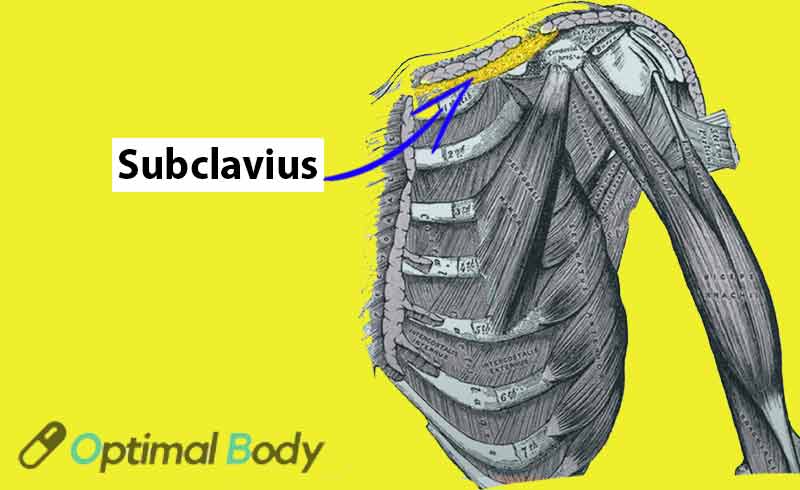
The subclavius muscle is a short, triangular thoracic wall muscle located beneath the clavicle.
It starts at the first rib and goes to the undersurface of the middle portion of the clavicle.
Cable Chest Workouts Benefits: Why cable exercises are better for bodybuilding?
Cable Exercises and Why They Are Beneficial:
Cable exercises, as well as other exercises using cables, are excellent because they provide constant and continuous tension to your muscles.
When using free weights, there are certain moments in the exercise where the load on your muscles decreases, or your joints close to support the weight.
A good example is the “Bicep Curl” exercise, where, at the top of the dumbbell curl, the weight becomes suspended, and there’s no actual load on your muscles. This gives you a moment of “rest” between the phases of the exercise.
Similarly, during a bench press, at the peak of the push, your elbows easily lock, and the weight rests momentarily on your skeletal structure. Again, you get a moment of “rest” between the phases of the exercise.
However, when using cables, there’s no “disconnection”, the loading continues consistently. This continuous loading puts greater stress on your muscles, helping them grow faster.
But this is not the only reason to include cable exercises in your workout.
Here are some additional benefits of using the cable machine:
- Adjustable Point of Origin: You can raise or lower the pulley to any angle you desire, allowing you to target your muscles from different angles. This gives you a more diverse workout than what you can achieve with free weights.
- Safer: Using the cable machine reduces the risk of increasing weights too quickly and injuring yourself. If the weight is too heavy, you won’t simply be able to lift a stack of weights. Using the cable machine significantly reduces the risk of injury.
- Activation of the Entire Body Muscles: With the cable machine, it’s not just the main muscle (in this case, your chest) that works alone, but all the secondary stabilizing muscles that maintain your balance and stability while standing. Your shoulders, arms, core, and even back and leg muscles are activated during the exercise. This burns more calories and helps you develop better overall functional strength.
- Functional and Versatile Movement: Functional and Versatile Movement: The cable machine allows you to execute any movement you like, including pushing, pulling, twisting, squatting, bending, lunging, and more. You can pull the cable or push it in any direction, giving you a greater variety of movements that enhance functional performance.
These are compelling reasons to incorporate cable chest exercises into your workout routine.
You can benefit from all the advantages of free weights, along with the added bonuses of continuous tension, increased safety, full-body muscle activation, and versatility that will make your training more dynamic.
Related: Best Chest Exercises To Do On A Smith Machine
How to Build a Stronger Chest with Cable Machine Workouts?
Warm-up:
Begin with a dynamic warm-up to get your blood flowing and prepare your chest muscles for the workout.
Perform arm circles, shoulder rotations, and light chest stretches for about 5-10 minutes.
Exercise Selection:
There are several cable exercises that target the chest muscles, such as cable flyes, cable chest press, and cable crossovers.
Each exercise works the chest muscles from different angles, providing a comprehensive workout.
Adjusting Intensity:
To target different training goals, adjust the weight load accordingly. For strength gains, use heavier weights with fewer reps (1 to 6 reps).
For hypertrophy, use moderate weights with more reps (8 to 12 reps). For endurance, use lighter weights with higher reps (15 to 20 reps).
Proper Form:
Focus on maintaining proper form throughout each exercise.
Keep your core engaged, chest up, and shoulders back and down. Avoid using excessive momentum or swinging during the movements.
Progressive Overload:
To continue making gains, gradually increase the weight load or repetitions over time.
This principle of progressive overload is essential for muscle growth and strength development.
Rest and Recovery:
Allow your chest muscles sufficient rest between workouts to recover and grow. Train your chest 1-2 times per week, depending on your fitness level and recovery capacity.
Top Cable Chest Exercises and How To Do Each One
1. Cable Crossover Exercise for Chest Hypertrophy:
This exercise is one of the best chest exercises using cables and is specifically aimed at developing the lower part of the chest (Pectoralis Major).
It resembles the Dumbbell Fly exercise, but it utilizes high cables and pulleys to place greater emphasis on the lower chest when pushing the hands downward and inward.
During the exercise, you will feel a good stretch in your chest as you open your arms wide in the initial phase and before reaching the united position in the center at the final phase.
This technique targets the outer portions of the chest to help you build a broader chest.
This exercise is highly effective and focuses on the “finishing touch” to enhance the inner chest, which may not be adequately targeted otherwise.
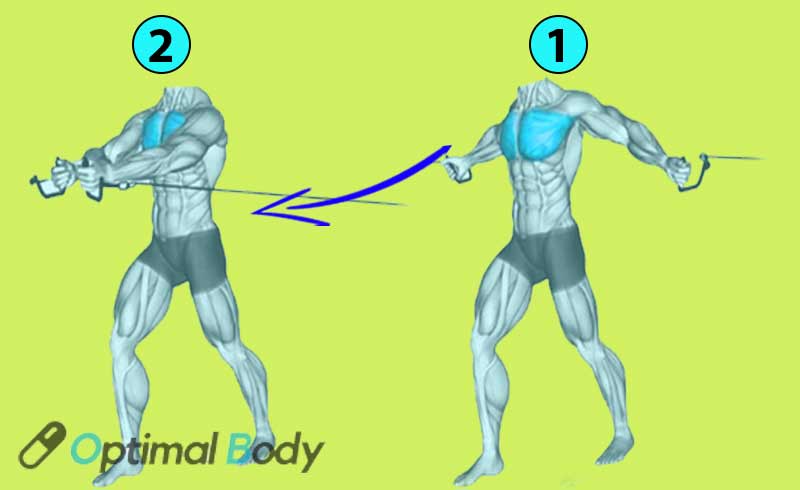
How To Perform Cable Crossover:
- Stand between two high pulleys.
- Grasp the left pulley handle with your left hand and the right pulley handle with your right hand firmly.
- Lean slightly forward by bending at your waist and knees.
- Rotate your shoulders inward until your elbows are at shoulder level.
- Keep your elbows slightly bent, and exhale slowly as you pull the handles down and toward your body as if hugging something.
- Continue the motion until you reach the desired count while feeling the pressure on your chest.
- Inhale slowly as you reverse the movement backward until you feel a slight stretch in your chest.
- Repeat this exercise for the recommended number of repetitions.
2. Incline Cable Fly:
Instead of using a heavy barbell for the incline press, try using cables.
You will need to exert effort to lift the weight upward, but even at the end, the cables will continue to engage your muscles. You won’t get a rest period at the end of the movement, as is the case with incline bench exercises using dumbbells.
And that’s not all! Due to the cable setup, your arms will tend to move slightly outward due to gravity’s pull on the cables.
This means your shoulder muscles and triceps will have to work to stabilize and control the handles during the upward and downward movement. This leads to quicker muscle fatigue and a better workout for secondary muscles.
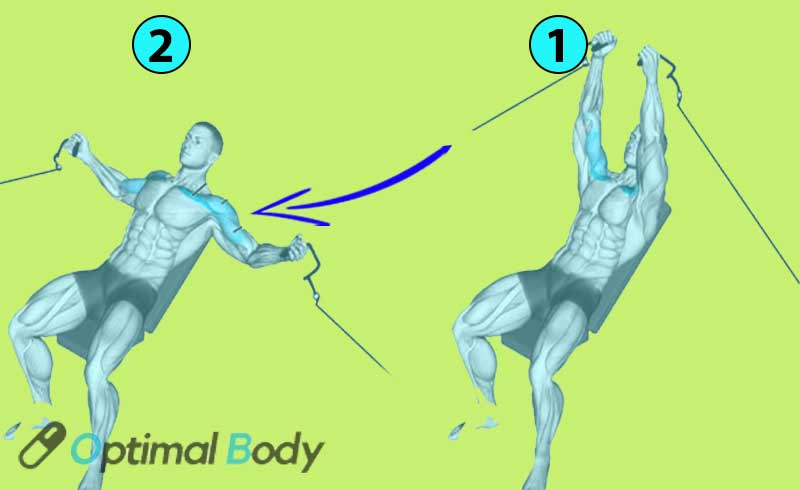
How To Do The Incline Cable Fly Exercise
- Place an incline bench between two low cable pulleys.
- Grab each cable handle and lie on your back between the pulleys, with your arms extended side by side.
- Slightly bend your elbows and rotate your shoulders inward to direct your elbows to the sides.
- Arch your back slightly and stretch your chest.
- Maintain a slight bend in your elbows and exhale as you pull the handles upward and inward in a hugging motion until your hands meet at the top.
- Keep the count as you reach two and press on your chest muscles.
- Inhale as you reverse the movement and slowly return the handles to the starting position until you feel a slight stretch in your chest or shoulders.
- Repeat.
3. Standing Incline Cable Fly:
Also called: Low to high cable chest fly
This exercise is similar to the cable fly exercise, but instead of pushing inward at chest level, you will push the cables inward and downward toward the abdominal area.
You should still position the handle at the highest level possible, but the inward movement will shift downward, focusing on the inner chest muscles.
This exercise is easier on the shoulders and wrists than the cable fly exercise. If you are recovering from an injury but still want to strengthen your inner chest muscles, this movement is safer and can be incorporated into your workouts!
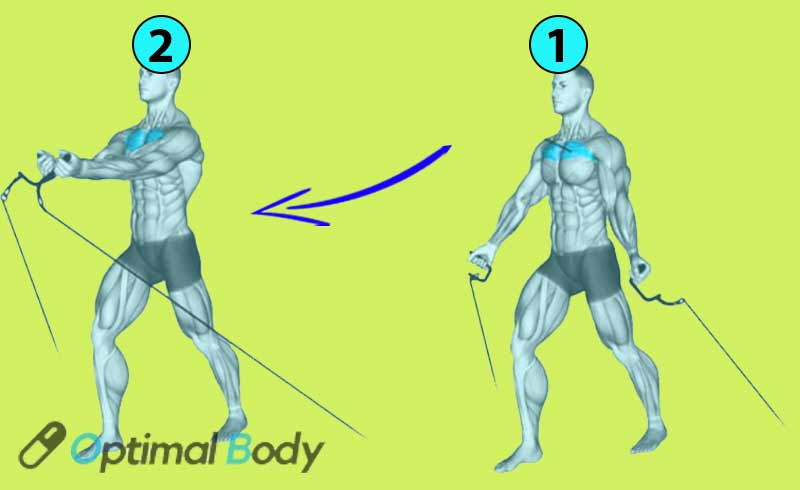
How To Perform Standing Incline Cable Fly:
- Stand between two low cable pulleys at shoulder height, holding one handle in each hand.
- Place one foot in front of the other for stability.
- Extend your arms slightly side by side with a slight bend at the elbows.
- Exhale as you press the handles forward and inward until your arms are fully extended and your shoulders are forward.
- Keep the count as you reach two and press on your chest muscles.
- Inhale as you reverse the movement until you feel a slight stretch in your chest.
- Repeat the exercise with the recommended number of reps.
4. Decline Cable Chest Fly:
The decline cable fly is an exercise that targets the lower chest using a cable machine and D-shaped handles.
It provides consistent resistance throughout the motion, ensuring a good workout for the chest muscles.
By standing in a split stance and using a neutral grip, you can maximize muscle activation at the top and range of motion at the bottom of the exercise.
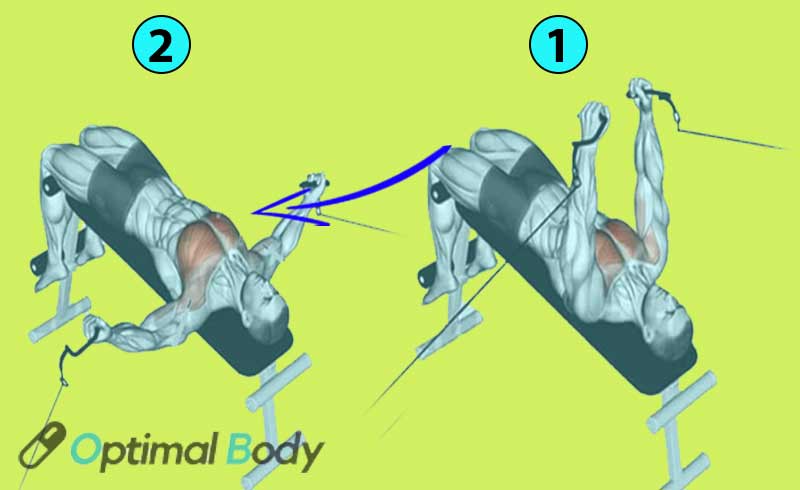
How To Do Decline Cable Fly:
- Place a decline bench between two low cable pulleys.
- Sit on the bench and hold one handle of each pulley in your hands.
- Lie on your back on the inclined bench and place your feet under the pads to secure them.
- Bend your elbows slightly and move your shoulders slightly inward, so that the elbows are level with the sides.
- Inhale, and as you exhale, press the handles upward and inward in a hugging motion until the handles meet each other at the top.
- Maintain the pressure for about two seconds and continue to contract your chest muscles.
- Inhale again, and as you return to the starting position, slowly release the handles until you feel a slight stretch in your chest or shoulders.
- Repeat this exercise for the recommended number of repetitions to reap its benefits.
5. Standing Decline Cable Fly:
The standing incline cable fly is an exercise used in strength training and bodybuilding to target the muscles of the chest (pectoral muscles).
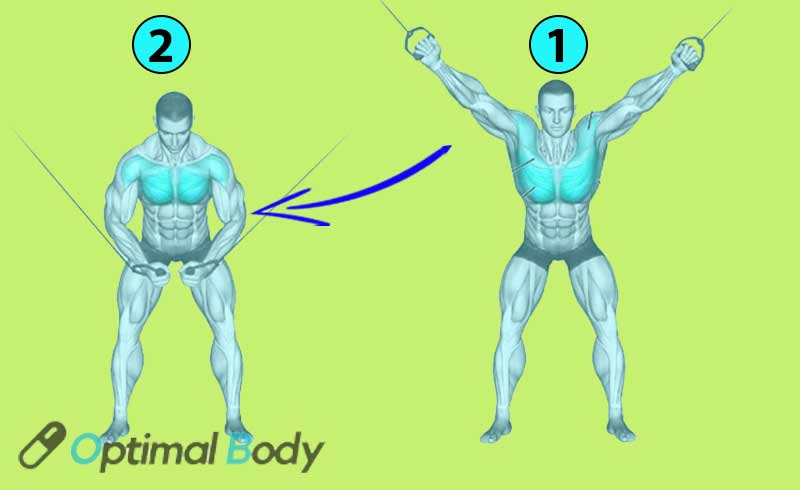
Here’s a step-by-step on how to perform the decline cable fly in a standing position:
- Begin by standing between two adjustable cable pulleys. Position each pulley to a height that is above your head.
- Grasp one D handle with each hand. The handles are attached to the cable pulleys.
- Take a step forward to create tension in the cables and extend your arms out in front of you until the cables are taut. Keep your elbows locked in a slightly bent position throughout the exercise.
- In an arching motion, bring the D handles together and downward until they meet at the top of the movement.
- During the movement, concentrate on engaging your chest muscles as the primary source of power.
- Hold the contraction for a brief moment, feeling the squeeze in your chest. Then, slowly release the D handles back to their starting position with control.
Engage Core: Throughout the entire exercise, remember to keep your abdominal muscles tight. Engaging your core helps stabilize your body and prevent injuries.
6. Cable Flat Bench Press:
The Cable Flat Bench Press is an exercise that targets the chest, shoulders, and triceps.
It differs from other versions of the bench press as it uses cables for resistance instead of traditional barbells or dumbbells.
This exercise requires stabilizing the arms against the cables, engaging more muscles in the shoulder area to keep the movement controlled.
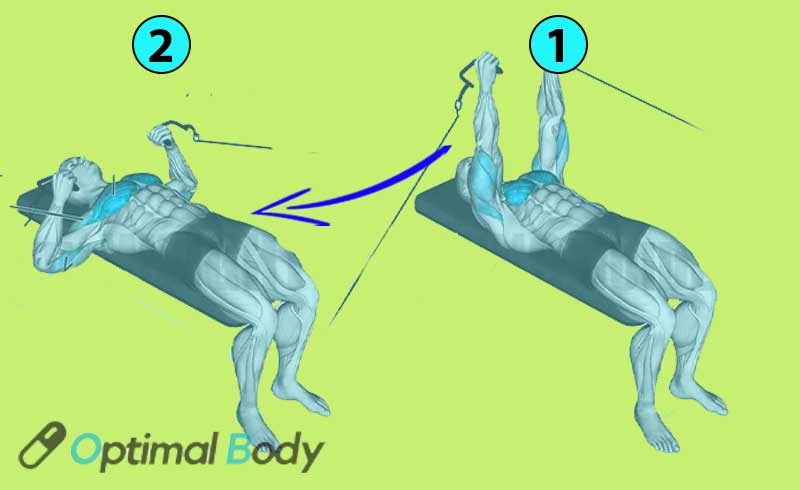
To perform the Cable Flat Bench Press, follow these steps:
- Place a bench in between the cable pulleys. Adjust the handles on the cables to be about a second from the bottom.
- Sit on the bench and lie back, grabbing one handle in each hand, just like you would in a machine bench press.
- Start by pushing the handles straight up, extending your arms fully. This is your starting position.
- Lower the handles down to about a 90-degree angle, bringing them towards your chest. Remember to breathe out as you push the handles up and breathe in as you lower them down.
- Continue performing the press for the desired number of repetitions.
Focus on Stability: Since the cables provide constant tension, you might notice your arms shaking a bit. Focus on stabilizing your arms throughout the movement.
7. Decline Cable Chest Press:
The Cable Decline Bench Press is an exercise that works on your chest, shoulders, and triceps muscles.
It’s similar to the Decline Dumbbell Bench Press but uses cables instead of dumbbells.
Using cables in this exercise keeps the muscles engaged and under tension throughout the movement, which is beneficial for building strength and muscle.

Here’s how you do it:
- Set up a Decline bench at a slight downward angle, about 30 degrees.
- Lie down on the bench with your feet placed flat on the foot pad or the roller.
- Hold the cable handles directly over your chest with your arms straight up from your shoulders.
- Slowly lower the handles outward until you feel your chest muscles stretching and tightening.
- Pause briefly in this position.
- Now, bring your arms back together towards the middle of your body, focusing on using your lower chest muscles to do the work.
8. Incline Cable Bench Press:
This exercise helps you develop the upper and middle chest area, as well as the strength of the front shoulder muscle.
You will feel the impact of the cables pulling your arms slightly outward, which requires engaging secondary muscles to maintain the range of motion “up and down” with minimal “inward and outward” movement.
The result is increased muscle tension, making it an excellent exercise for the shoulders, arm muscles, and even the core.
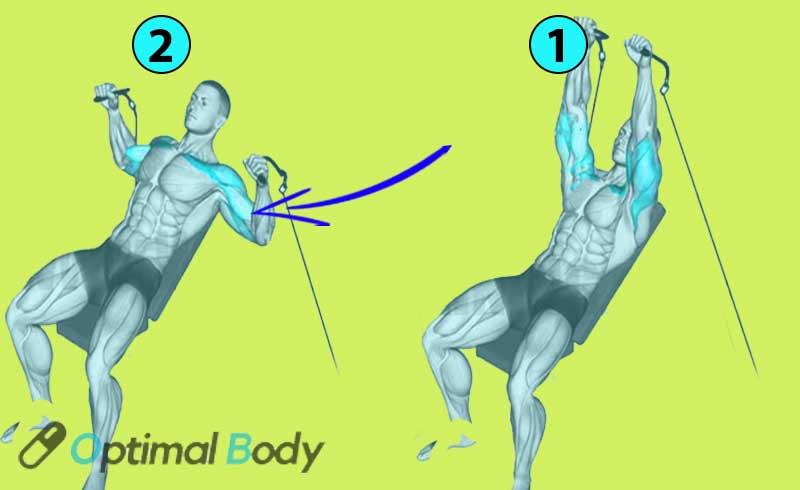
How To Do Incline Cable Bench Press:
- Adjust the bench to a 45-degree angle between two low cable pulleys.
- Grab the handles and lie on your back on the bench, placing your feet on the ground.
- Position the handles on the sides of your chest, bend your elbows, and keep them slightly close to your body.
- Inhale and press the handles upward and inward until they meet each other.
- Maintain the count as you reach the top and keep pressing on your chest.
- Exhale slowly and begin reversing the movement, lowering the handles back to the starting position until you feel a slight stretch in your chest or shoulders.
- Repeat the exercise with the recommended number of repetitions.
References:
- Alves, R. R., Viana, R. B., Silva, M. H., Guimarães, T. C., Vieira, C. A., Santos, D. A. T., et al. (2019). Postactivation potentiation improves performance in a resistance training session in trained men. J. Strength Cond. Res. 1. doi: 10.1519/JSC.0000000000003367. [Epub ahead of print].
- Bruno Ribeiro, Ana Pereira, Ana R. Alves, Pedro P. Neves, Mário C. Marques, Daniel A. Marinho, Henrique P. Neiva. Specific warm-up enhances movement velocity during bench press and squat resistance training. J. Mens. Health 2021, 17(4), 226–233. https://doi.org/10.31083/jomh.2021.069
- Marquina, M.; Lorenzo-Calvo, J.; García-Sánchez, C.; Rubia, A.d.l.; Rivilla-García, J.; Ferro-Sánchez, A. How Does Instability Affect Bench Press Performance? Acute Effect Analysis with Different Loads in Trained and Untrained Populations. Sports 2023, 11, 67. https://doi.org/10.3390/sports11030067
- Nasu H, Yamaguchi K, Nimura A, Akita K. An anatomic study of structure and innervation of the serratus anterior muscle. Surg Radiol Anat. 2012 Dec;34(10):921-8. doi: 10.1007/s00276-012-0984-1. Epub 2012 May 26. PMID: 22638721.
- Lung K, St Lucia K, Lui F. Anatomy, Thorax, Serratus Anterior Muscles. [Updated 2022 Sep 26]. In: StatPearls [Internet]. Treasure Island (FL): StatPearls Publishing; 2023 Jan-. Available from: https://www.ncbi.nlm.nih.gov/books/NBK531457/
- Bench Press Calculator - April 22, 2024
- Press to Handstand: Ultimate Step-by-Step Guide - April 22, 2024
- Cable Press (How To Do, Benefits, Targeted Muscles, Alternative) - April 22, 2024

